trailer FORD MONDEO 2006 2.G Owners Manual
[x] Cancel search | Manufacturer: FORD, Model Year: 2006, Model line: MONDEO, Model: FORD MONDEO 2006 2.GPages: 198, PDF Size: 4.69 MB
Page 5 of 198
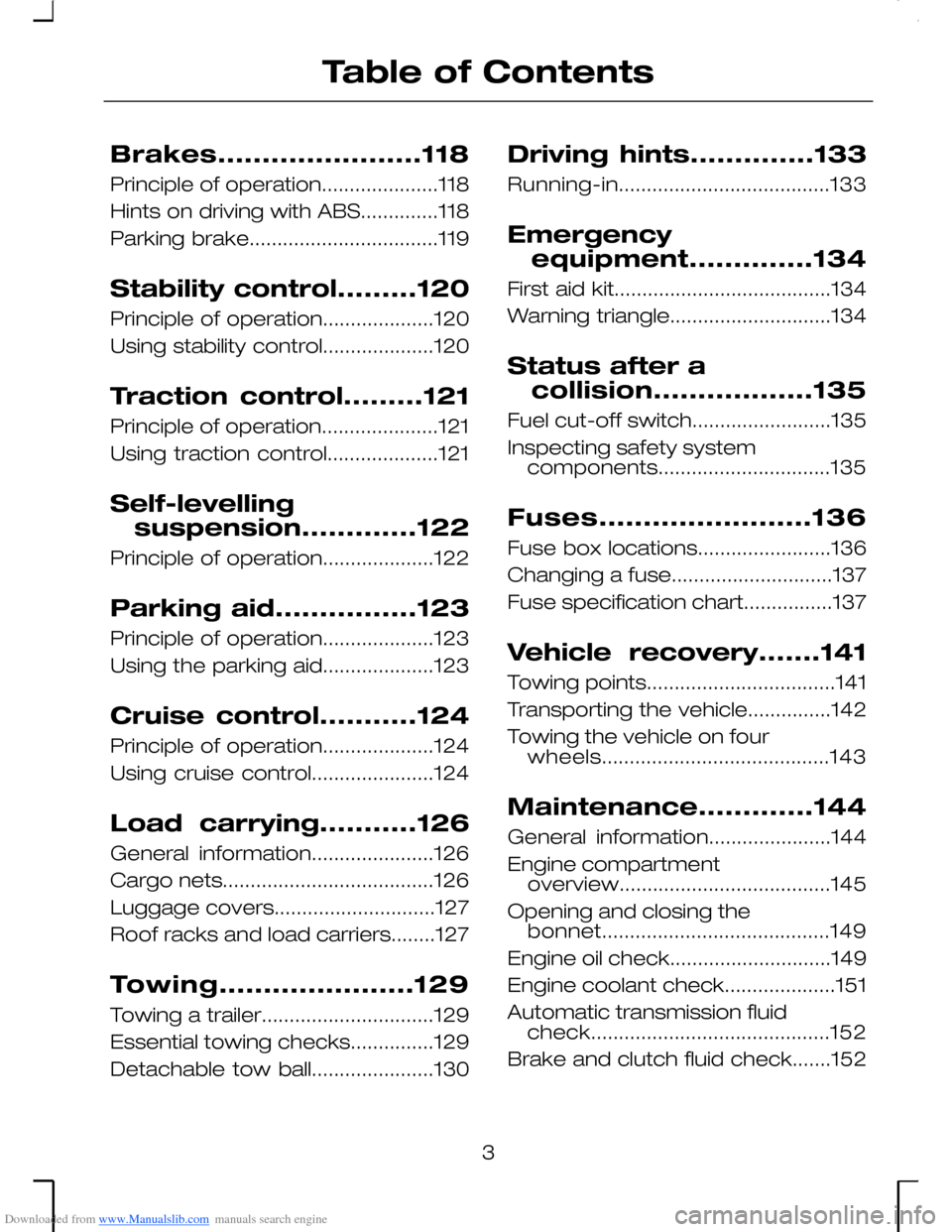
Downloaded from www.Manualslib.com manuals search engine Brakes.......................118
Principle of operation.....................118
Hints on driving with ABS..............118
Parking brake..................................119
Stability control.........120
Principle of operation....................120
Using stability control....................120
Traction control.........121
Principle of operation.....................121
Using traction control....................121
Self-levelling
suspension.............122
Principle of operation....................122
Parking aid................123
Principle of operation....................123
Using the parking aid....................123
Cruise control...........124
Principle of operation....................124
Using cruise control......................124
Load carrying...........126
General information......................126
Cargo nets......................................126
Luggage covers.............................127
Roof racks and load carriers........127
Towing......................129
Towing a trailer...............................129
Essential towing checks...............129
Detachable tow ball......................130
Driving hints..............133
Running-in......................................133
Emergency
equipment..............134
First aid kit.......................................134
Warning triangle.............................134
Status after a
collision..................135
Fuel cut-off switch.........................135
Inspecting safety systemcomponents...............................135
Fuses........................136
Fuse box locations........................136
Changing a fuse.............................137
Fuse specification chart................137
Vehicle recovery.......141
Towing points..................................141
Transporting the vehicle...............142
Towing the vehicle on fourwheels.........................................143
Maintenance.............144
General information......................144
Engine compartmentoverview......................................145
Opening and closing thebonnet.........................................149
Engine oil check.............................149
Engine coolant check....................151
Automatic transmission fluidcheck...........................................152
Brake and clutch fluid check.......152
3
Table of Contents
Page 58 of 198

Downloaded from www.Manualslib.com manuals search engine Recommended headlamp levelling control positions
Control positionLoad
EstateSaloonLoad inluggagecompart-ment1
Persons
with self-level. susp.withoutself-level.susp.
Rear seatsFront seats
000--1-2
01212-31-2
02222max.131-2
123232max.1-1
1 See Technical specifications (page 173).
2Control position must be increased by 0.5 on vehicles with 2.0 l Duratorq-TDCi
or 2.5 l Duratec-VE engines and automatic transmission. Higher controlpositions (+1) may be necessary when towing a trailer.
HAZARD WARNING
FLASHERS
Press the switch to turn on or off. Thehazard warning flashers can also beoperated when the ignition is off.
DIRECTION INDICATORS
56
LightingE72166 E72167
Page 76 of 198
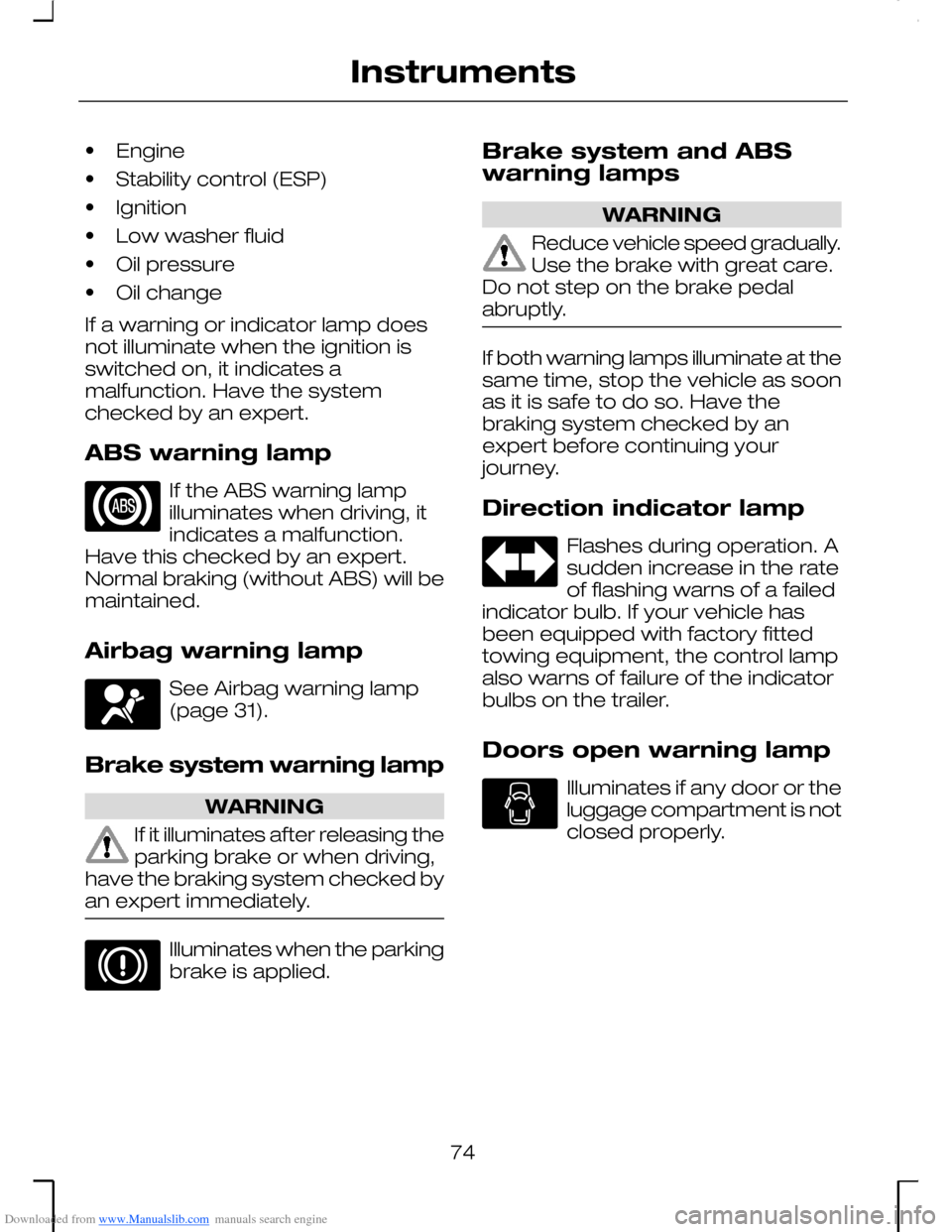
Downloaded from www.Manualslib.com manuals search engine •Engine
•Stability control (ESP)
•Ignition
•Low washer fluid
•Oil pressure
•Oil change
If a warning or indicator lamp doesnot illuminate when the ignition isswitched on, it indicates amalfunction. Have the systemchecked by an expert.
ABS warning lamp
If the ABS warning lampilluminates when driving, itindicates a malfunction.Have this checked by an expert.Normal braking (without ABS) will bemaintained.
Airbag warning lamp
See Airbag warning lamp(page 31).
Brake system warning lamp
WARNING
If it illuminates after releasing theparking brake or when driving,have the braking system checked byan expert immediately.
Illuminates when the parkingbrake is applied.
Brake system and ABSwarning lamps
WARNING
Reduce vehicle speed gradually.Use the brake with great care.Do not step on the brake pedalabruptly.
If both warning lamps illuminate at thesame time, stop the vehicle as soonas it is safe to do so. Have thebraking system checked by anexpert before continuing yourjourney.
Direction indicator lamp
Flashes during operation. Asudden increase in the rateof flashing warns of a failedindicator bulb. If your vehicle hasbeen equipped with factory fittedtowing equipment, the control lampalso warns of failure of the indicatorbulbs on the trailer.
Doors open warning lamp
Illuminates if any door or theluggage compartment is notclosed properly.
74
Instruments
Page 119 of 198
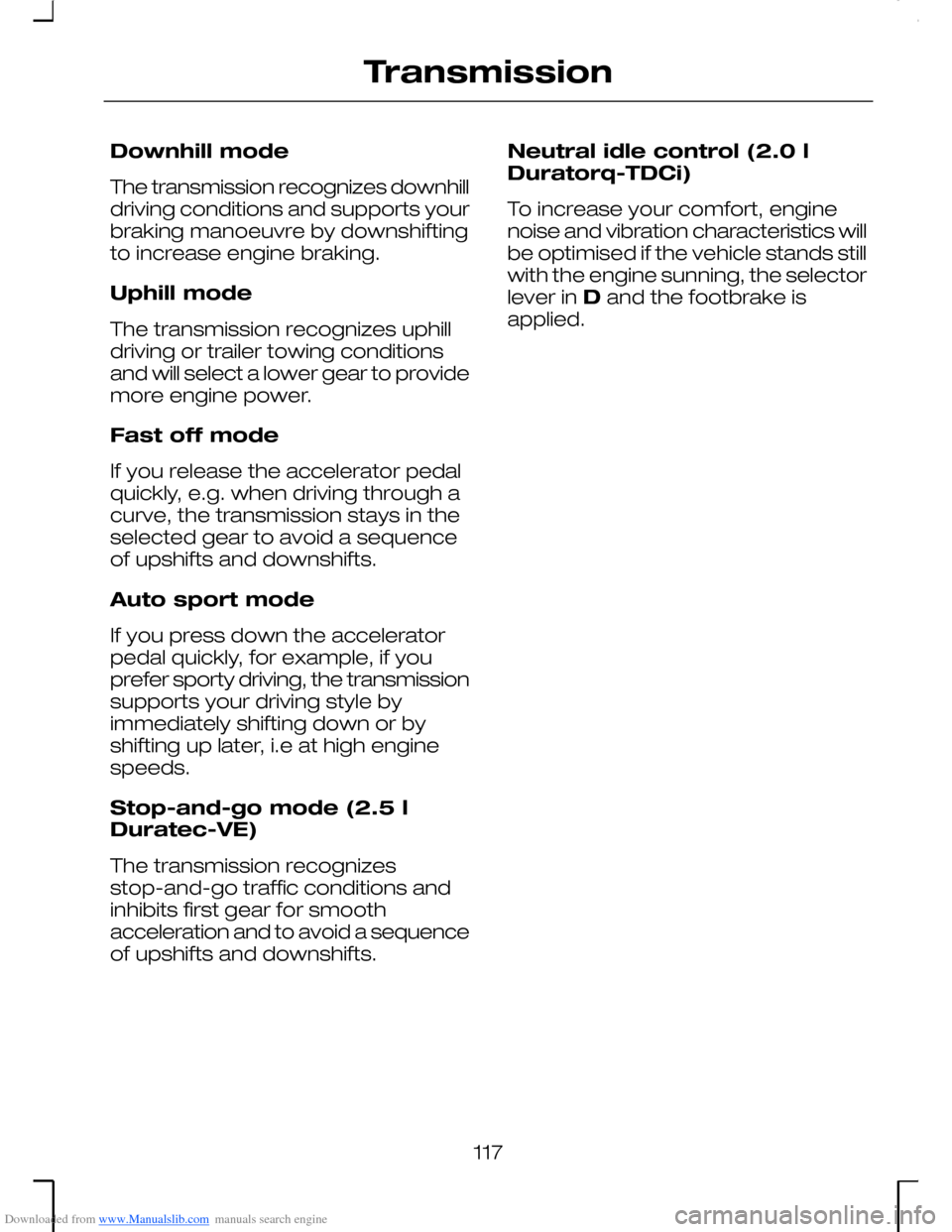
Downloaded from www.Manualslib.com manuals search engine Downhill mode
The transmission recognizes downhilldriving conditions and supports yourbraking manoeuvre by downshiftingto increase engine braking.
Uphill mode
The transmission recognizes uphilldriving or trailer towing conditionsand will select a lower gear to providemore engine power.
Fast off mode
If you release the accelerator pedalquickly, e.g. when driving through acurve, the transmission stays in theselected gear to avoid a sequenceof upshifts and downshifts.
Auto sport mode
If you press down the acceleratorpedal quickly, for example, if youprefer sporty driving, the transmissionsupports your driving style byimmediately shifting down or byshifting up later, i.e at high enginespeeds.
Stop-and-go mode (2.5 lDuratec-VE)
The transmission recognizesstop-and-go traffic conditions andinhibits first gear for smoothacceleration and to avoid a sequenceof upshifts and downshifts.
Neutral idle control (2.0 lDuratorq-TDCi)
To increase your comfort, enginenoise and vibration characteristics willbe optimised if the vehicle stands stillwith the engine sunning, the selectorlever in D and the footbrake isapplied.
117
Transmission
Page 131 of 198
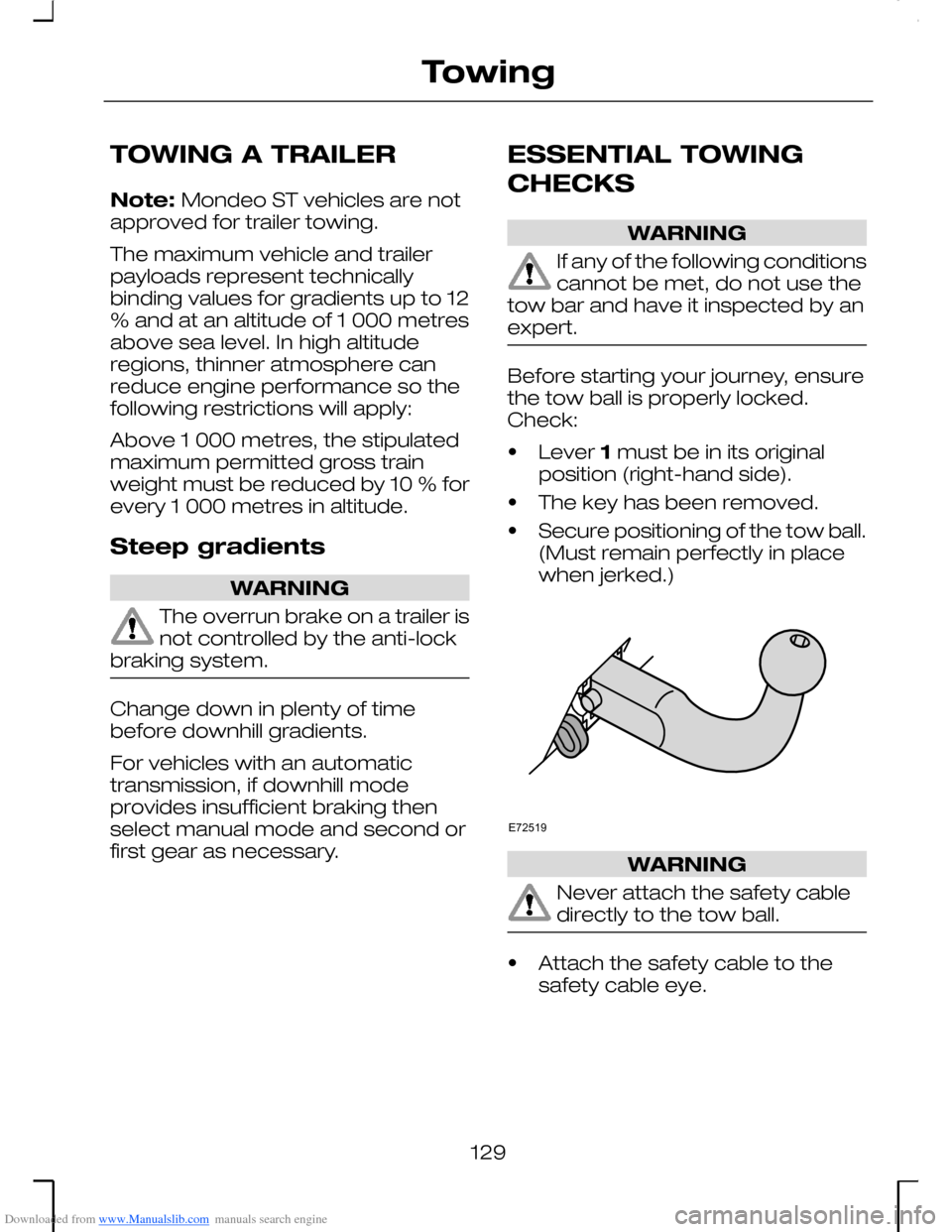
Downloaded from www.Manualslib.com manuals search engine TOWING A TRAILER
Note: Mondeo ST vehicles are notapproved for trailer towing.
The maximum vehicle and trailerpayloads represent technicallybinding values for gradients up to 12% and at an altitude of 1 000 metresabove sea level. In high altituderegions, thinner atmosphere canreduce engine performance so thefollowing restrictions will apply:
Above 1 000 metres, the stipulatedmaximum permitted gross trainweight must be reduced by 10 % forevery 1 000 metres in altitude.
Steep gradients
WARNING
The overrun brake on a trailer isnot controlled by the anti-lockbraking system.
Change down in plenty of timebefore downhill gradients.
For vehicles with an automatictransmission, if downhill modeprovides insufficient braking thenselect manual mode and second orfirst gear as necessary.
ESSENTIAL TOWING
CHECKS
WARNING
If any of the following conditionscannot be met, do not use thetow bar and have it inspected by anexpert.
Before starting your journey, ensurethe tow ball is properly locked.Check:
•Lever 1 must be in its originalposition (right-hand side).
•The key has been removed.
•Secure positioning of the tow ball.(Must remain perfectly in placewhen jerked.)
WARNING
Never attach the safety cabledirectly to the tow ball.
•Attach the safety cable to thesafety cable eye.
129
TowingE72519
Page 132 of 198
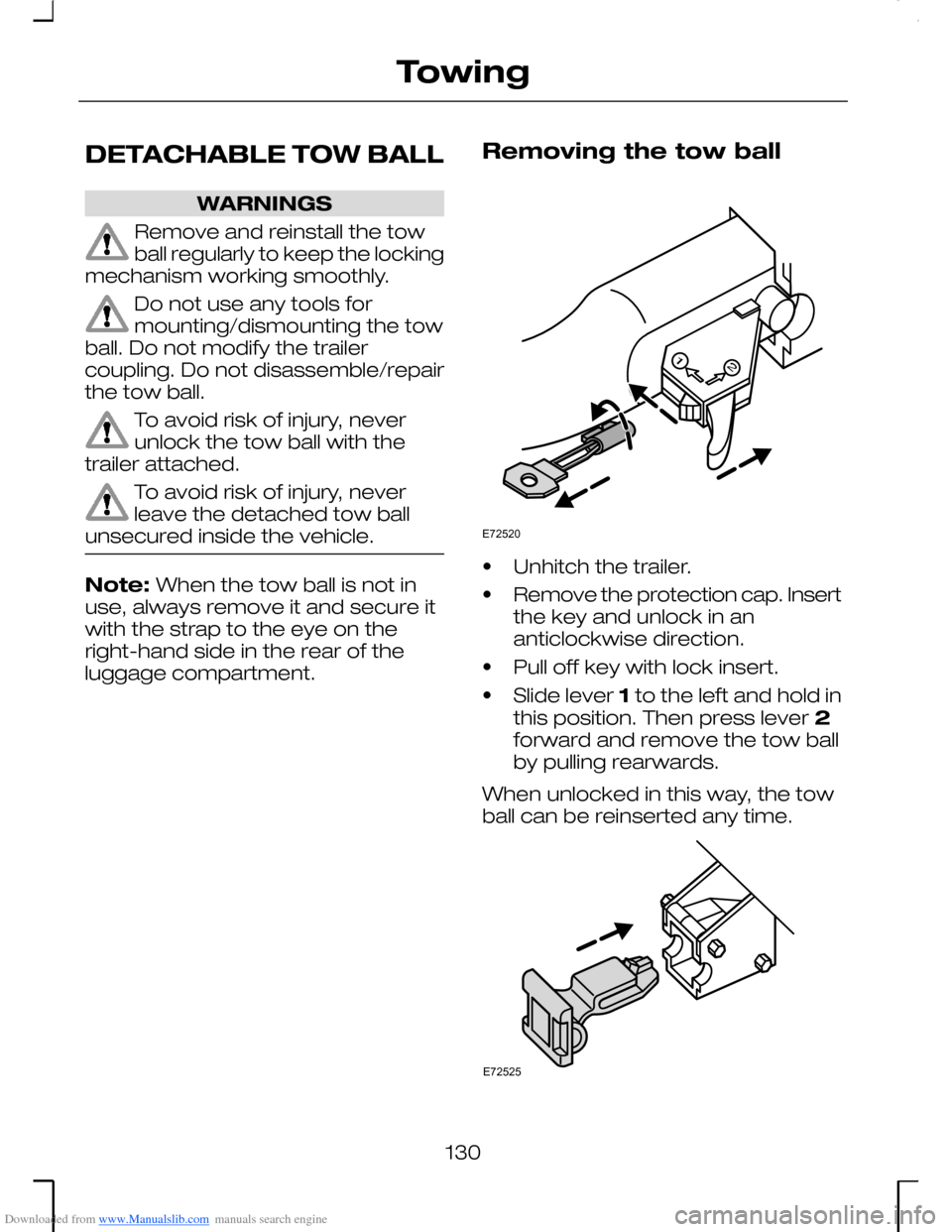
Downloaded from www.Manualslib.com manuals search engine DETACHABLE TOW BALL
WARNINGS
Remove and reinstall the towball regularly to keep the lockingmechanism working smoothly.
Do not use any tools formounting/dismounting the towball. Do not modify the trailercoupling. Do not disassemble/repairthe tow ball.
To avoid risk of injury, neverunlock the tow ball with thetrailer attached.
To avoid risk of injury, neverleave the detached tow ballunsecured inside the vehicle.
Note: When the tow ball is not inuse, always remove it and secure itwith the strap to the eye on theright-hand side in the rear of theluggage compartment.
Removing the tow ball
•Unhitch the trailer.
•Remove the protection cap. Insertthe key and unlock in ananticlockwise direction.
•Pull off key with lock insert.
•Slide lever 1 to the left and hold inthis position. Then press lever 2forward and remove the tow ballby pulling rearwards.
When unlocked in this way, the towball can be reinserted any time.
130
TowingE72520 E72525
Page 133 of 198

Downloaded from www.Manualslib.com manuals search engine •Insert the plug.
•Insert the cover from underneathuntil it engages.
Installing the tow ball
•Remove the cover (depending onmodel variant) from the rearbumper. Grab the cover fromunderneath with both hands andcarefully pull it off downwards.
•Pull out the plug.
WARNINGS
Special care should be takenwhen fitting the tow ball, as thesafety of the vehicle and the trailerdepends on this.
The tow ball may only beinserted when completelyunlocked.
131
TowingE72527 E72521 E72522 E72523
Page 140 of 198
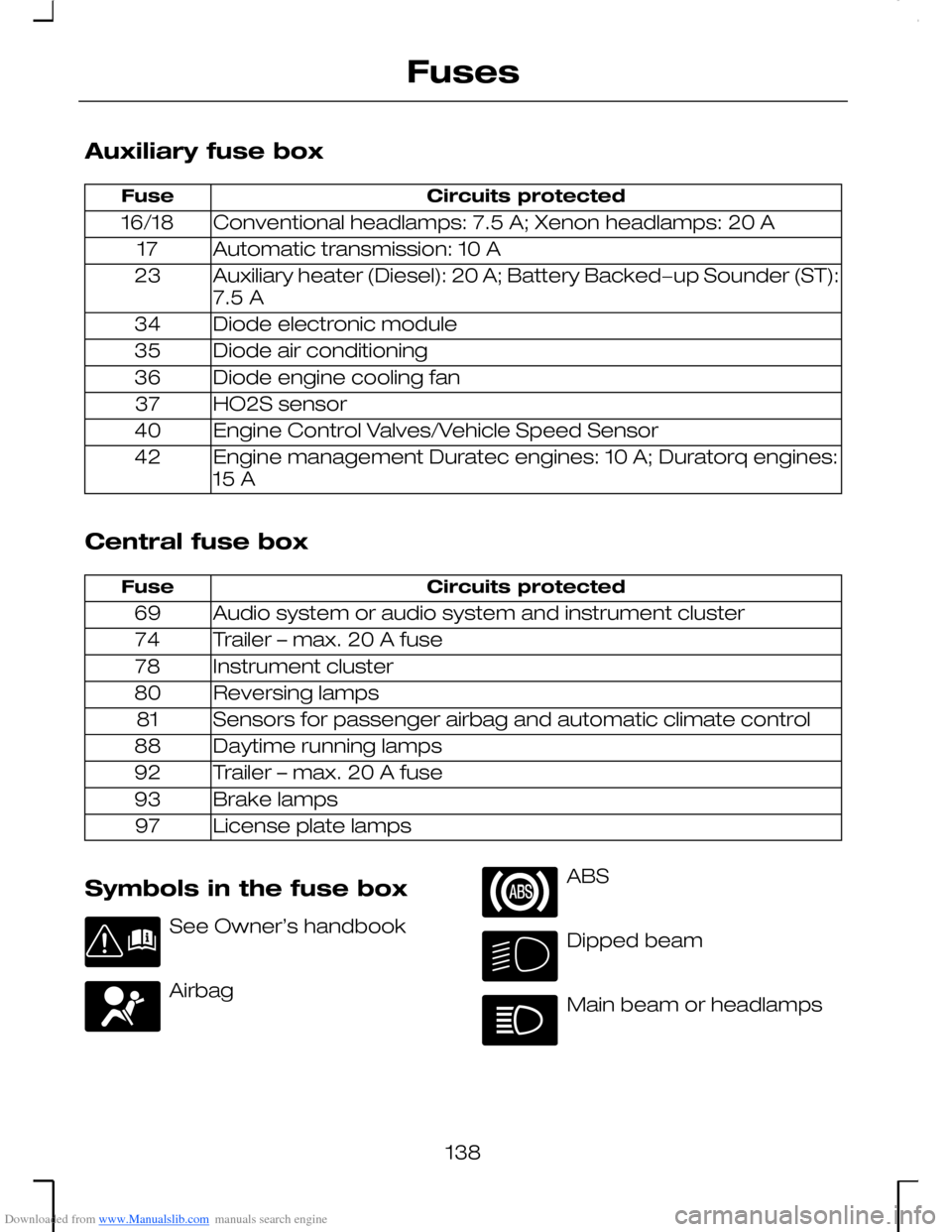
Downloaded from www.Manualslib.com manuals search engine Auxiliary fuse box
Circuits protectedFuse
Conventional headlamps: 7.5 A; Xenon headlamps: 20 A16/18
Automatic transmission: 10 A17
Auxiliary heater (Diesel): 20 A; Battery Backed−up Sounder (ST):7.5 A23
Diode electronic module34
Diode air conditioning35
Diode engine cooling fan36
HO2S sensor37
Engine Control Valves/Vehicle Speed Sensor40
Engine management Duratec engines: 10 A; Duratorq engines:15 A42
Central fuse box
Circuits protectedFuse
Audio system or audio system and instrument cluster69
Trailer – max. 20 A fuse74
Instrument cluster78
Reversing lamps80
Sensors for passenger airbag and automatic climate control81
Daytime running lamps88
Trailer – max. 20 A fuse92
Brake lamps93
License plate lamps97
Symbols in the fuse box
See Owner’s handbook
Airbag
ABS
Dipped beam
Main beam or headlamps
138
Fuses
Page 194 of 198
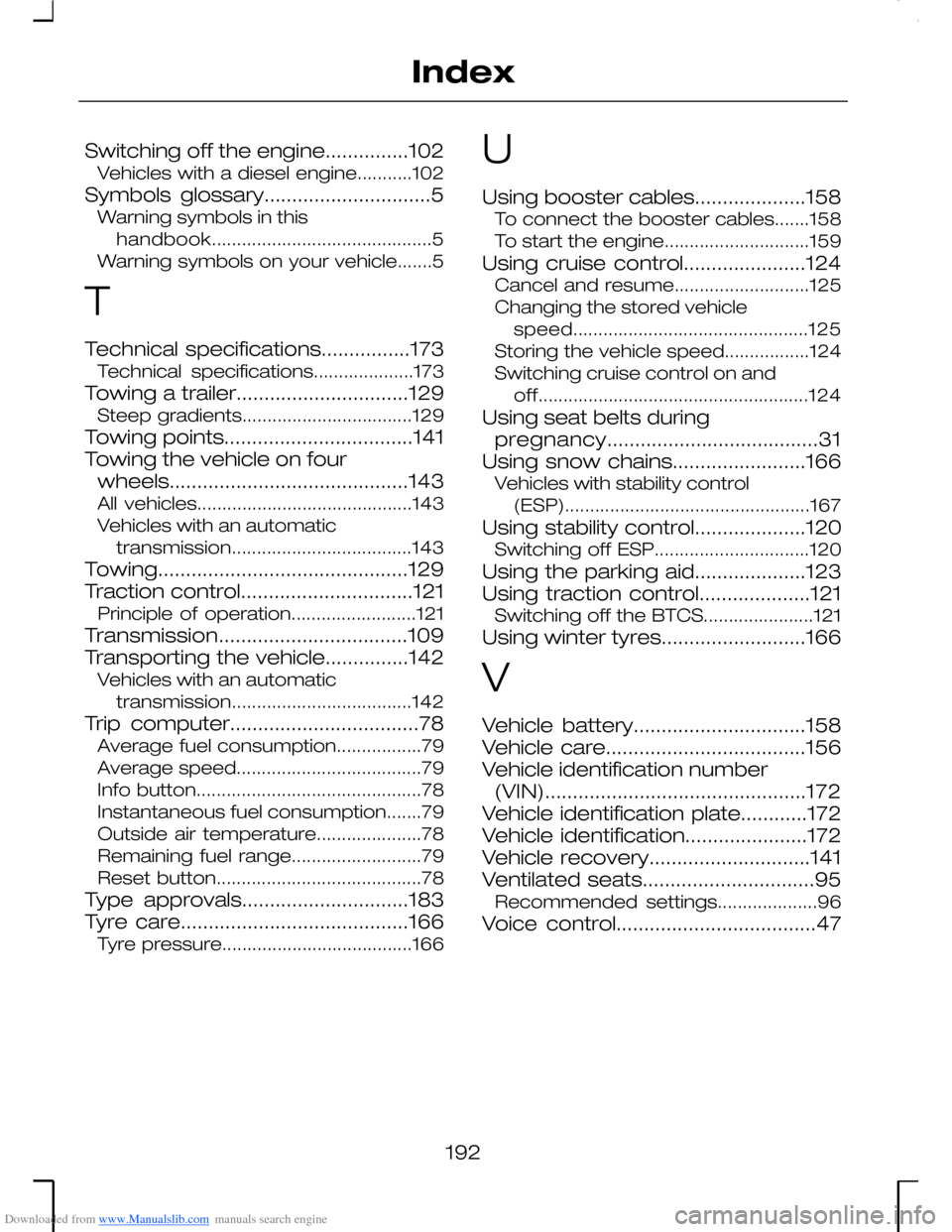
Downloaded from www.Manualslib.com manuals search engine Switching off the engine...............102Vehicles with a diesel engine...........102
Symbols glossary..............................5Warning symbols in thishandbook............................................5Warning symbols on your vehicle.......5
T
Technical specifications................173Technical specifications....................173
Towing a trailer...............................129Steep gradients..................................129
Towing points..................................141Towing the vehicle on fourwheels...........................................143All vehicles...........................................143Vehicles with an automatictransmission....................................143
Towing.............................................129Traction control...............................121Principle of operation.........................121
Transmission..................................109Transporting the vehicle...............142Vehicles with an automatictransmission....................................142
Trip computer..................................78Average fuel consumption.................79Average speed.....................................79Info button.............................................78Instantaneous fuel consumption.......79Outside air temperature.....................78Remaining fuel range..........................79Reset button.........................................78
Type approvals..............................183Tyre care.........................................166Tyre pressure......................................166
U
Using booster cables....................158To connect the booster cables.......158To start the engine.............................159
Using cruise control......................124Cancel and resume...........................125Changing the stored vehiclespeed...............................................125Storing the vehicle speed.................124Switching cruise control on andoff......................................................124
Using seat belts duringpregnancy......................................31Using snow chains........................166Vehicles with stability control(ESP).................................................167
Using stability control....................120Switching off ESP...............................120
Using the parking aid....................123Using traction control....................121Switching off the BTCS......................121
Using winter tyres..........................166
V
Vehicle battery...............................158Vehicle care....................................156Vehicle identification number(VIN)...............................................172Vehicle identification plate............172Vehicle identification......................172Vehicle recovery.............................141Ventilated seats...............................95Recommended settings....................96
Voice control....................................47
192
Index